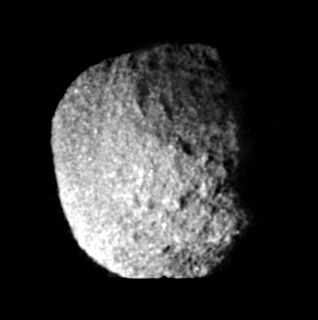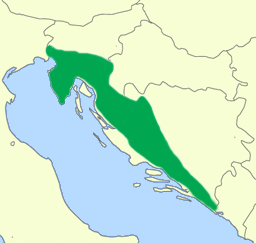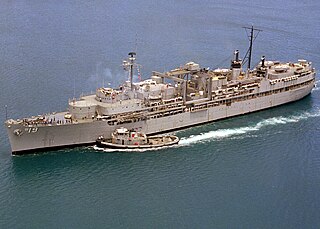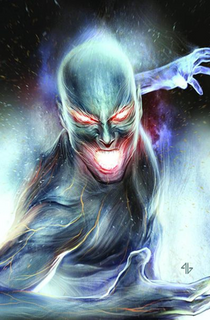
In Greek mythology, Proteus is an early prophetic sea-god or god of rivers and oceanic bodies of water, one of several deities whom Homer calls the "Old Man of the Sea" (halios gerôn). Some who ascribe to him a specific domain call him the god of "elusive sea change", which suggests the constantly changing nature of the sea or the liquid quality of water in general. He can foretell the future, but, in a mytheme familiar to several cultures, will change his shape to avoid having to; he will answer only to someone who is capable of capturing the beast. From this feature of Proteus comes the adjective protean, with the general meaning of "versatile", "mutable", "capable of assuming many forms". "Protean" has positive connotations of flexibility, versatility and adaptability.

Proteus, also known as Neptune VIII, is the second-largest Neptunian moon, and Neptune's largest inner satellite. Discovered by Voyager 2 spacecraft in 1989, it is named after Proteus, the shape-changing sea god of Greek mythology. Proteus orbits Neptune in a nearly equatorial orbit at the distance of about 4.75 times the radius of Neptune's equator.

The Two Gentlemen of Verona is a comedy by William Shakespeare, believed to have been written between 1589 and 1593. It is considered by some to be Shakespeare's first play, and is often seen as showing his first tentative steps in laying out some of the themes and motifs with which he would later deal in more detail; for example, it is the first of his plays in which a heroine dresses as a boy. The play deals with the themes of friendship and infidelity, the conflict between friendship and love, and the foolish behaviour of people in love. The highlight of the play is considered by some to be Launce, the clownish servant of Proteus, and his dog Crab, to whom "the most scene-stealing non-speaking role in the canon" has been attributed.

The Bristol Proteus was the Bristol Engine Company's first mass-produced gas turbine engine design, a turboprop that delivered just over 4,000 hp (3,000 kW). The Proteus was a reverse-flow gas turbine. Because the second turbine drove no compressor stages, but only the propeller, this engine was classified as a free-turbine. It powered the Bristol Britannia airliner, small naval patrol craft, hovercraft and electrical generating sets. It was also used to power a land-speed record car, the Bluebird-Proteus CN7. After the merger of Bristol with Armstrong Siddeley the engine became the Bristol Siddeley Proteus, and later the Rolls-Royce Proteus.

Proteus syndrome is a rare disorder with a genetic background that can cause tissue overgrowth involving all three embryonic lineages. Patients with Proteus syndrome tend to have an increased risk of embryonic tumor development. The clinical and radiographic manifestations of Proteus syndrome are highly variable. Yet, the orthopedic manifestations of the syndrome are unique. The syndrome is named after the Greek sea-god Proteus, who could change his shape. The condition appears to have been first described in the American medical literature by Samia Temtamy and John Rogers in 1976. Michael Cohen described it in 1979. Only a few more than 200 cases have been confirmed worldwide, with estimates that about 120 people are currently alive with the condition. As attenuated forms of the disease may exist, there could be many people with Proteus syndrome who remain undiagnosed. Those most readily diagnosed are also the most severely disfigured.

Proteus vulgaris is a rod-shaped, nitrate-reducing, indole+ and catalase-positive, hydrogen sulfide-producing, Gram-negative bacterium that inhabits the intestinal tracts of humans and animals. It can be found in soil, water, and fecal matter. It is grouped with the Enterobacteriaceae and is an opportunistic pathogen of humans. It is known to cause wound infections and other species of its genera are known to cause urinary tract infections.

The olm or proteus is an aquatic salamander in the family Proteidae, the only exclusively cave-dwelling chordate species found in Europe. In contrast to most amphibians, it is entirely aquatic; it eats, sleeps, and breeds underwater. Living in caves found in the Dinaric Alps, it is endemic to the waters that flow underground through the extensive limestone bedrock of the karst of Central and Southeastern Europe, specifically southern Slovenia, the basin of the Soča River near Trieste, Italy, southwestern Croatia, and Bosnia and Herzegovina. Introduced populations are found near Vicenza, Italy, and Kranj, Slovenia.

The third USS Proteus (AS-19) was a Fulton-class submarine tender in the United States Navy.

The Scaled Composites Model 281 Proteus is a tandem-wing High-Altitude Long Endurance aircraft designed by Burt Rutan to investigate the use of aircraft as high altitude telecommunications relays. The Proteus is actually a multi-mission vehicle, able to carry various payloads on a ventral pylon.

Proteus mirabilis is a Gram-negative, facultatively anaerobic, rod-shaped bacterium. It shows swarming motility and urease activity. P. mirabilis causes 90% of all Proteus infections in humans. It is widely distributed in soil and water.

Demon Seed is a 1977 American science fiction–horror film directed by Donald Cammell. It stars Julie Christie and Fritz Weaver. The film was based on the novel of the same name by Dean Koontz, and concerns the imprisonment and forced impregnation of a woman by an artificially intelligent computer. Gerrit Graham, Berry Kroeger, Lisa Lu and Larry J. Blake also appear in the film, with Robert Vaughn uncredited as the voice of the computer.
Young Allies is the name of three fictional superhero teams appearing in American comic books published by Marvel Comics.

Kevin MacTaggert, best known as Proteus and also called Mutant X, is a character appearing in American comic books published by Marvel Comics. The character is commonly associated with the X-Men.

Two Gentlemen of Verona is a rock musical, with a book by John Guare and Mel Shapiro, lyrics by Guare and music by Galt MacDermot, based on the Shakespeare comedy of the same name.
Daniele Cacia is an Italian footballer who currently plays as a striker for Serie C side Novara. He is a former Italy Under 19 International.

Cacia is a civil parish in the municipality of Aveiro. The population in 2011 was 7,354, in an area of 35.75 km².

Proteus is a 2013 exploration and walking simulator video game created and designed by Ed Key and David Kanaga for Microsoft Windows, OS X, Linux, PlayStation 3 and PlayStation Vita. It allows the player to freely explore a procedurally-generated environment, without predetermined goals. The world's flora and fauna emit unique musical signatures, combinations of which cause dynamic shifts in audio, based on the player's surroundings.

Cacia is a genus of longhorn beetles of the subfamily Lamiinae, containing the following species:

The Proteus Design Suite is a proprietary software tool suite used primarily for electronic design automation. The software is used mainly by electronic design engineers and technicians to create schematics and electronic prints for manufacturing printed circuit boards.

Cacia cretifera is a species of beetle in the family Cerambycidae. It was described by Frederick William Hope in 1831. It is known from Java, Cambodia, India, Myanmar, China, Nepal, Thailand, Laos, and Vietnam. It feeds on Berberis thunbergii and Albizia julibrissin.



















